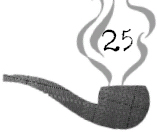
THE ADVENTURE OF THE ARCHWAY OPERATOR
One of the last cases recorded in Watson’s notes involved the criminal fraternity’s use – or misuse – of the rapidly expanding telephone system. It centred around a series of daring bank raids in and around London’s Highgate Archway during the summer of 1911.
In broad daylight, three masked men, armed with heavy pistols, forced their way into branches of the Westminster, National Provincial and Lloyds banks. After terrifying staff and customers by firing several pistol shots, shooting dead a customer in one raid and seriously injuring a teller in another, the gang threatened to kill everyone in the building unless ‘all the cash you’ve got’ was handed over. In every instance, they left with over £10,000 stuffed into a large leather holdall.
The Metropolitan Police scoured the underworld in vain for information that might identify the robbers – those who in normal circumstances might have grassed in exchange for a reward kept their mouths tightly shut for fear of reprisal. Whoever the ‘Archway Gang’ (as they were known in the press) were, they were certainly ruthless.
The bravery of a passer-by finally brought the raids to an end. Standing by the door of a branch of Lloyds Bank as the thieves were running out with their loot, the man made a grab at the mask of the last one to leave. The knotted red handkerchief fell away to reveal the unmistakable face of Jo Yendle, a notorious criminal who had twice before been imprisoned for theft. The rogue turned and beat his assailant to the ground with his pistol. He would almost certainly have killed him had not a crowd gathered and forced Yendle to the pavement, where he was held until the arrival of the police. In the meantime, the other two members of the gang had made their getaway in a stolen motor car.

Though charged with murder in addition to other offences, Yendle refused to reveal the names of the two members of his gang who had escaped. The only item of interest in his possession when arrested was a notebook. It contained several dates and hastily scribbled figures in what was identified as Yendle’s handwriting. One page seemed of particular interest. Under the heading ‘Agreement’ was a series of telephone numbers with percentage signs beneath them:
HAMPSTEAD |
847 |
ABBEY |
758 |
MOORGATE |
212 |
PADDINGTON |
887 |
DILIGENCE |
001 |
EDGWARE |
666 |
NATIONAL |
992 |
= 30% |
= 15% |
When the police asked the operator to call these numbers, they were told either that the number did not exist, or that, where it was genuine, the subscriber clearly had no link to criminal activity.
In the end, the detectives working on the case took the notebook to Sherlock Holmes in the hope that he could work out what the numbers meant. Within twenty minutes he had revealed the names of the two missing members of the Archway Gang.
Who were they?
Find the answer/s here.